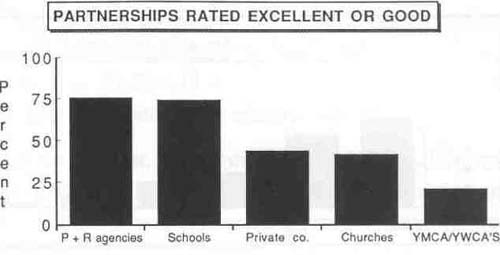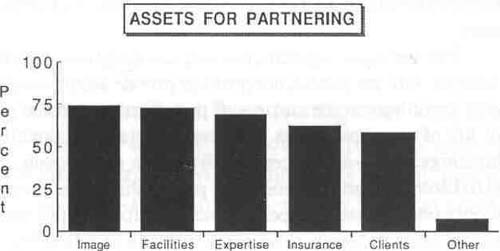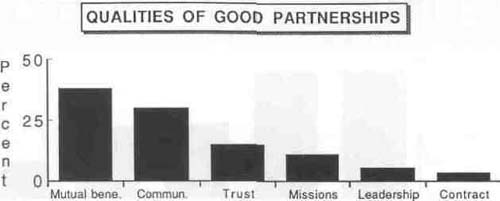INTERGOVERNMENTAL COOPERATION
by Daniel G. Yoder, Ph.D., CLP
A random sample of 141 Illinois park districts and municipal park and recreation departments received questionnaires in June 1996. Surveys were addressed to the executive directors and superintendents of the agencies. If park districts listed no director in the 1995-1996 IAPD/IPRA Membership Directory and Buyers' Guide, surveys were addressed to the president of the park district boards. Ninety-six surveys were completed and returned. This represents a 68% return rate and approximately one-third of the park districts and park and recreation departments in the state of Illinois. The random nature of the sample and the high questionnaire return rate allows for inferences to Illinois park districts and municipal park and recreation departments in general. For the purposes of the study, "partnerships" were broadly defined. They included agreements, cooperative ventures and other joint arrangements, both formal and informal. In addition, partnerships included short-term and long-term cooperative agreements. According to survey results, partnerships are indeed essential to the success of their organizations. Only two of the 96 respondents said that partnerships were of little importance to their organizations. Forty percent (40%) reported that partnerships were important and 58% reported that partnerships were extremely important. Furthermore, partnerships are expected to be even more important in the future. Twenty-seven percent (27%) reported that partnerships will be important, and a remarkable 72% reported that partnerships will be extremely important to the success of local leisure service agencies in the next decade. Partnerships are virtually ubiquitous and incredibly diverse. Every park district or park and recreation department in the state enjoys some partnerships. Of the three sectors (public, nonprofit and private) that local public leisure service providers deal with, the public sector is the site of the most partnerships. Ninety-five percent (95%) of the respondents noted that they had some partnerships with other public sector agencies including schools, cities, villages, county boards, police departments and social service agencies. Not surprisingly, these agreements contribute most to park districts' and park and recreation departments' ability to fulfill their mandates. Nonprofit sector and private sector partnerships follow in descending order. More than half (52%) of the leisure service agencies reported they had partnerships with all three sectors. 8 • Illinois Park & Recreation • September/October 1996 Partnerships with schools are by far the single most important agreements for park districts and park and recreation departments. Fifty-two percent (52%) of the agencies reported that these agreements were the single most important partnerships. Twenty-three percent (23%) said that partnerships will be important, and 72% reported that partnerships will be extremely important to the success of local leisure service agencies in the next decade. Twenty-three percent (23%) said that partnerships with municipalities were most important. Other most important partnerships (a combined 25%) included those with special recreation agencies, service clubs and other park districts.
Effectiveness of Partnerships
Partnerships with other public leisure service providers
(park districts and park and recreation departments) were rated
highest with 76% of the directors or presidents reporting excellent or good relationships. School partnerships were a close
second with 74% reporting excellent or good relationships.
Forty-four percent (44%) of the park districts or park and recreation departments had excellent or good relationships with
private leisure service enterprises and 42% had excellent or good
relationships with churches.
Interestingly, only 21% of leisure service agencies reported excellent or good relationships with YMCA/YWCAs. In fact, 61% of the agencies surveyed reported no relationships at all with YMCA/YWCAs. Only a small part of this can be attributed to a lack of availability of YMCA/YWCAs, because the vast majority of districts or departments had these organizations within their boundaries.
Types of Partnerships
Partnerships that include an exchange and/or use of facilities are most prominent. Only 8% reported that the majority of
their agreements involve only agreements on programs. Sixty-
nine percent (69%) reported that the majority of their joint arrangements involve only exchange and/or use of facilities.
Twenty-three percent (23%) reported that the majority of their
agreements involve both exchanges and/or use of facilities and
agreements on programs. The exchange and/or use of facilities
plays a role in the partnerships of 92% of all the agencies responding.
Money does not seem to play a significant role in partnerships. Twenty-seven percent (27%) of the agencies indicated that none of their partnerships involve any exchange of money at all. Sixty-nine percent (69%) reported that money was involved in less than half of their partnerships. Approximately two-thirds of the partnerships (63%) are formal and consist of written contracts between the parties. The remaining 36% of the partnerships are informal and operate on verbal and handshake agreements. The vast majority of respondents indicate a general trend in the past decade with agreements becoming increasingly formalized. This movement to formality has not created serious problems for most responding agencies. A few respondents noted, however, that the process of formalizing agreements has resulted in an extended time period for arranging partnerships and reduced flexibility in modifying the terms of the agreements.
Assets for Partnering
Park districts and park and recreation departments of municipalities have a variety of attributes that make them attractive to potential partners. Ninety-seven percent (97%) of the
agencies reported having multiple desirable qualities. The most
common agency asset (reported by 73% of the agencies) is
positive image and reputation in the community. Facilities, both
indoor and outdoor, also helped create a positive situation for
encouraging partnerships. Recognized expertise, liability insurance coverage, and loyal park district clients were also recognized as very valuable assets.
Qualities of Partnerships
What qualities are consistently found in effective partnerships and what qualities are found in partnerships that fail to
deliver benefits to partners and constituents? Directors and presidents displayed a thoroughly pragmatic perspective on these
topics. While trust and leadership were noted as important qualities, two very practical qualities were rated as contributing significantly more to effective partnerships: the realization of
mutual benefits (38%) and ongoing communication (30%).
Trust, the compatibility of partners' missions, leadership and
the use of formal contracts followed in order of contribution to
effective partnerships.
The most common barriers to good partnerships were not a mirror image of the qualities for good partnerships, although there were some similarities. Lack of communication was reported far and away as the most common barrier to good partnerships. One of three respondents reported that this was the greatest barrier to good cooperative arrangements. Other barriers were not close in terms of the number of times they were selected. Lack of trust was the second most common impediment to good partnerships. Only 11% of the respondents believed that a lack of mutual benefits was the greatest barrier to good partnerships. Other barriers included lack of leadership,incompatibility of missions, liability, and lack of a formal contract. Illinois Parks & Recreation • September/October 1996 • 9
Partnerships, agreements and cooperative ventures— whether with the public, nonprofit or private sector—undoubtedly contribute to the success of park districts and the quality of life of our constituents. However, they are not unmitigated blessings. Sixty-six percent (66%) of the respondents recognized some negative elements of partnerships. The most commonly cited negative aspect of partnerships was the resulting loss of control. Nearly three times as many people (63%) cited this negative aspect than any other. Unrealistic expectations that went unfulfilled, poor quality of programs, failure to receive credit and failure to provide services to all constituents were also reported in order of frequency.
Conclusion and Discussion
A picture of the partnerships enjoyed by Illinois park districts and park and municipal recreation departments emerges
from this initial study.
• These arrangements are primarily located in the public sector with the most common agreements between local leisure service agencies, school districts and municipalities. • Successful ongoing partnerships are based on all partners receiving significant benefits. • Good communication is present in effective partnerships and absent in those that do not meet the expectations of the various parties. • Of the many assets that local leisure service agencies have, public image and facilities are reported as the most attractive. • While partnerships contribute a great deal to the success of the park district or the park and recreation department, they are not without negative aspects. Loss of control is the major issue, but several other aspects also reduce the effectiveness of partnerships. How can this research be more than just a collection of interesting information? How can it help local leisure providers continue to provide leisure opportunities for the people of Illinois? This study revealed several troublesome issues that must be considered. Let's consider just a couple. First, there is an unsettling issue involving communication, evaluation and the loss of control. We know that clear and consistent communication between partners is common to good partnerships; when it does not exist there is less chance for effective joint arrangements. Given that, it is remarkable that only 9% of the survey respondents indicate their agencies have any type of systematic partnership evaluation. Communication and evaluation tend to take place only when there is a problem; in many cases the issue has reached a point of no return and finding solutions is extremely challenging. Regularly scheduled evaluations (on at least an annual basis) are proactive and can be instrumental in heading off these crises. Evaluations can determine if the goals of the partnership have been met. When desired results have not been realized modifications can be made to remedy the situation. Systematic evaluations can also help with most of the commonly cited negative aspect of partnerships—the loss of control. In most cases, leisure service agencies do not have control of their partnerships taken away as much as they quietly surrender it to their partners. Many partnerships involve agencies or groups that are based heavily on that single partnership with the park district or the park and recreation department. Sports leagues are a prime example. On the other hand, the leisure service provider may have a hundred or more partnerships. Incidentally, 43% of the park district directors and presidents reported they were more aware of the number of partnerships in which they were involved after they filled out the questionnaire. Is it possible that we simply have too many partnerships to take care of? The partnering group can devote all of its energies to this single arrangement. As a result, the leisure service provider may experience some loss of control. Systematic evaluations can help leisure service agencies retain a level of control by guaranteeing that partners meet to discuss goals and possible modifications to the agreement. A second issue involves a potentially serious side effect of the critical role that facilities play in partnerships. Facilities are one of the leisure service providers' key assets. However, different areas within the agency may benefit unequally from cooperative arrangements. The questionnaire queried how people felt about the following statement: The recreation/programming departments usually benefits much less. Administrators were significantly divided on this issue. Thirty-two percent (32%) either agreed or strongly agreed while 46% disagreed or strongly disagreed. Twenty-one percent (21%) were neutral on the issue. If leisure service agencies are not currently dealing with this problem, there is the distinct possibility that they may be forced to face it in the near future. Illinois park districts and park and recreation departments are in the enviable position of managing important recreation departments and enjoying a very positive image in the community. This, among other attributes, makes them very desirable partners. Also, leisure service agencies have such an impressive track record in partnerships that 58% of the respondents reported acting as facilitators of partnerships that do not even directly include them. The time is at hand to aggressively pursue all of our partnering opportunities, fully aware of our assets and benefits, and equally mindful of the hurdles and pitfalls. Daniel G. Yoder, Ph.D., CLP, is an assistant professor in the Recreation, Park and Tourism Administration Department at Western Illinois University. His research and teaching interests are in the provision of leisure services at the local public level. Yoder is a panel member for the session "Cooperate, Don't Compete...Cutting Edge Partnerships" at the 1997 IAPD/IPRA Annual Conference. 10 • Illinois Parks & Recreation • September/October 1996 |
||||||||||||||



